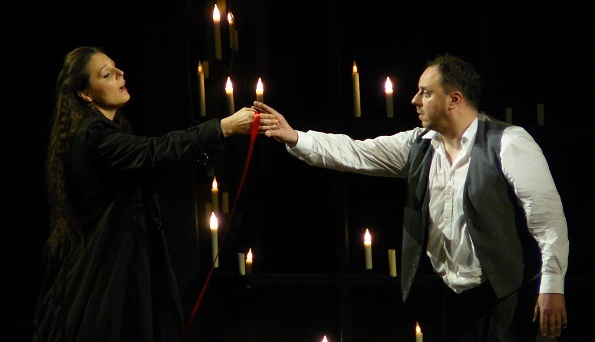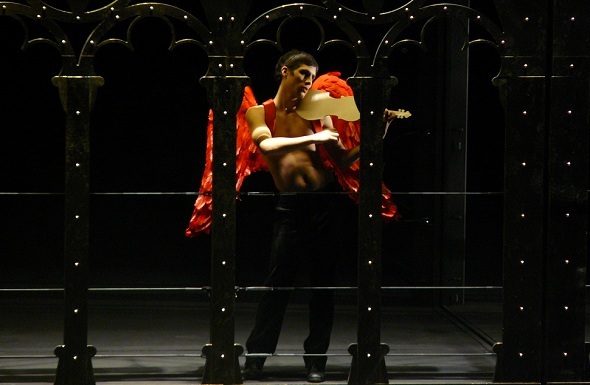
Painting with music
On November 16, the Opéra National de Paris, debuted a production of Paul Hindemith’s opera “Mathis le peintre” (Mathis der Maler), at the Opéra Bastille. This spectacular and complex production, directed by Olivier Py, will enter into the company’s repertoire, and deservedly. For the opera, which is seldom presented, is beautifully written and provides insight into the dilemma of the artist within the political and materialistic world of contemporary culture. The production pays homage to the essential questions of creative genius that the opera poses.
The Mathis at the center of the opera’s action is the painter Mathis Grünewald, the creator of the Issenheim Altarpiece, an extraordinary work, massive in size and haunting in vision. A Northern Renaissance artist working at the same time as Albrecht Durer, Grünewald painted in a manner notable for its dramatic fantasy and its unrelenting detail: the supernatural, good and evil, is picked out in vibrant color and movement, and there is no question that the crucified Christ is suffering, his body covered with small cuts, his fingers tensely curled.
When closed the altarpiece shows the crucifixion, flanked by portraits of Sts. Sebastian and Anthony. This central painting opens into tableaus of the Annunciation, a concert of angels, a scene from the childhood of Christ and the Resurrection. And these in turn open to a final portrait of St. Anthony flanked by Jerome and Augustine, with a stunningly bizarre vision of St. Anthony plagued by demons on the altarpiece’s right-hand panel.
Although the opera presents a more traditional heroic story, Hindemith’s music is often inspired by a particul
ar tableau from the altarpiece. The overture, for example, is a recreation of the central crucifixion. Three descriptive musical interludes were reworked into the symphonic version of “Mathis der Maler.”
The production uses tableaux vivants of these three panels as a background to the more conventionally heroic story of Mathis’ struggle with the political factions of the Peasants’ War. Forming a kind of proscenium behind the front of the stage is the outline of the Issenheim Altarpiece. Within that frame, mute actors move, pl
acing themselves in scenes echoing the crucifixion, or the angels’ concert, or, more exotically, the temptation of St. Anthony with writhing half-naked temptresses and animal-headed demons. Elaborate gold balconies sparkling with small lights take their place on the stage, moving up from below the stage and suggesting the several levels of illuminated architecture that comprise the altarpiece. The angels are decked with bright red wings. A figure in gold armor stands silently on the glittering balcony.

This allegorical approach to the music’s descriptive character is also embedded in the director’s interpretation of the opera. Hindemith’s libretto sets the opera during the early decades of the 16th century, in the middle of the Peasants’ War, a struggle fused by Luther’s Protestant Reformation but fueled by economic struggles between classes. The opera opens with the leader of the peasants’ revolt asking Mathis for refuge, which he gives, placing himself in a dangerous and vulnerable position with both the nobility and the cardinal for whom he works. Later, Mathis will save the Countess Helfenstein from the peasant army that invades Königshofen castle and kills the Count. His allegiance is to the individual and to his own sense of compassion, rather than political causes.
None of this narrative, however, is staged in 16th-century Germany; rather the costuming and much of the sets (Pierre-André Weitz) evoke a generic Nazi Germany. German shepherd dogs are held on short leash while ranks of uniformed soldiers burn banned books.
Py and company use the story of Mathis as a parallel to Hindemith’s own life, which while he was composing the opera, was hindered and threatened by the rise of Nazism. Not only unconventional in his musical tastes, Hindemith had married Gertrud Rottenberg, the daughter of the Jewish conductor, Ludwig Rottenberg. The composer was the target of constant political abuse and censorship. “Mathis der Maler” was completed in 1935 but debuted in 1938 in Zurich; from there Hindemith emigrated to the United States, where he remained until 1953.
In the opera Grünewald finally retreats from the politics surrounding him, taking refuge in the Odenwald forest, where he has the visions that become the Issenheim Altarpiece, his final and truest gift to the world, and which are described in Hindemith’s libretto through musical metaphors: “Die Welt ist erfüllt von göttlichem Schall,/ Im Herzen der Menschen ein Wilderhall” (Divine music fills the entire world, and resounds in the hearts of humankind).
The cutting back and forth between story line and tableaux along with the use of multiple staging devices, such as the hydraulic stages, gave the staging a spectacular but rather random quality. Everything was tied together, however, by the gorgeous aesthetics that emphasized grandeur of size and a dramatic use of black, white, gray and gold with splashes of a vivid and sensuous clear red.
Matthias Goerne sang the role of Mathis, and the casting could not have been better. With his warmly shaded, heart-luring baritone and slightly feverish personality, he epitomized the artist, isolated, innocent and driven by obsessional, internal visions. On the last night of the run, the house apologized for his not being well, but Goerne would have to be bed ridden for his voice not to be resonantly appealing: he sounded great. He was supported by an excellent cast. Tenor Scott MacAllister sang the Cardinal Albrecht von Brandenburg, his ally and patron, with a brighter sound that offset and complemented Goerne’s honeyed tone. The magnetic Melanie Diener sang Ursula, Mathis’ love, and Martina Welschenbach, blessed with an extraordinarily sweet and crystalline soprano, sang Regina, the daughter of the rebel leader. Her father, Hans Schwalb, was stalwartly sung by tenor Michael Weinius. The host of singers was each suitable, and the large chorus, directed by Patrick Marie Aubert, was excellent.
Maestro Christoph Eschenbach conducted the orchestra of L’Opéra National de Paris, with focus and intelligence, bringing out the incisiveness of the brass, the delicacy of the strings and the dissonant and visionary strangeness in this admirable work.
—Jaime Robles
Photos: Above: Matthias Goerne as Mathis and Melanie Diener as Ursula. Below: An angel from the Angelic Concert of “Mathis le peintre.”
